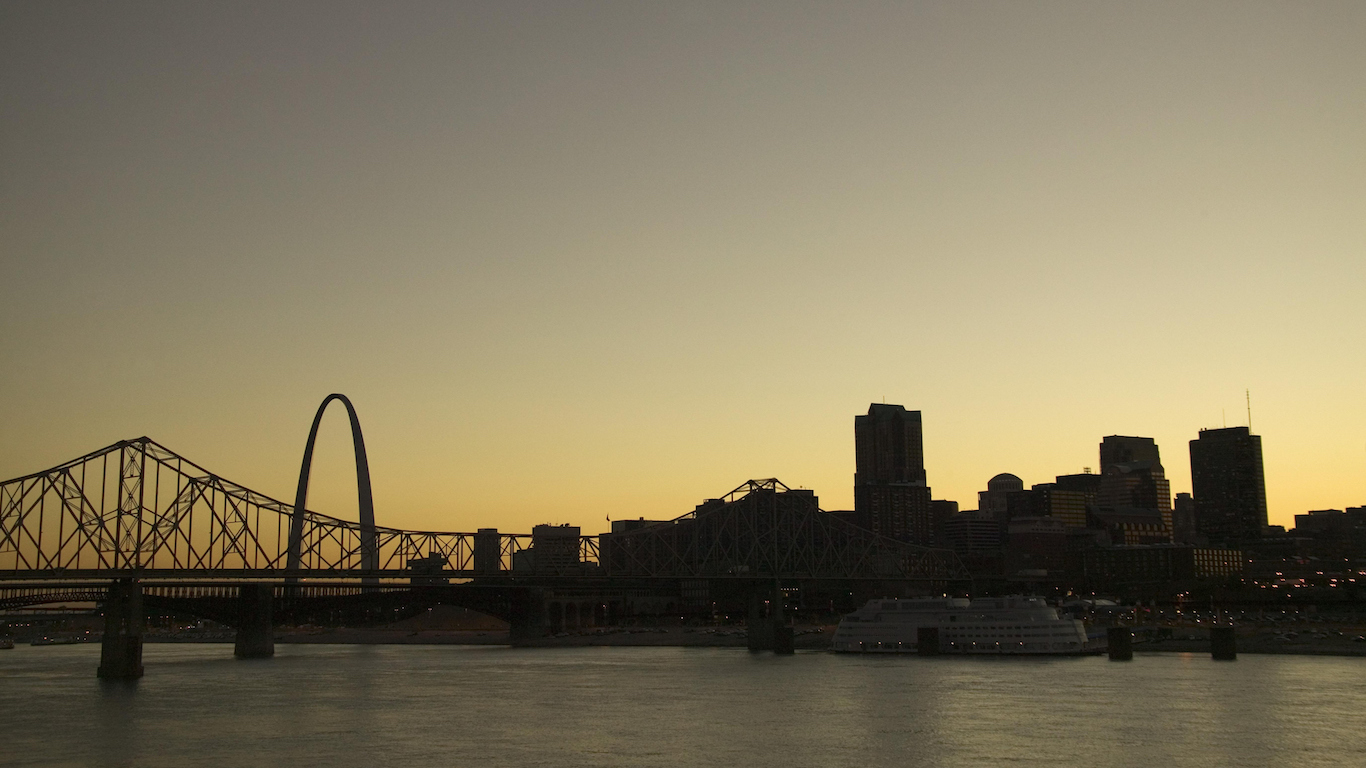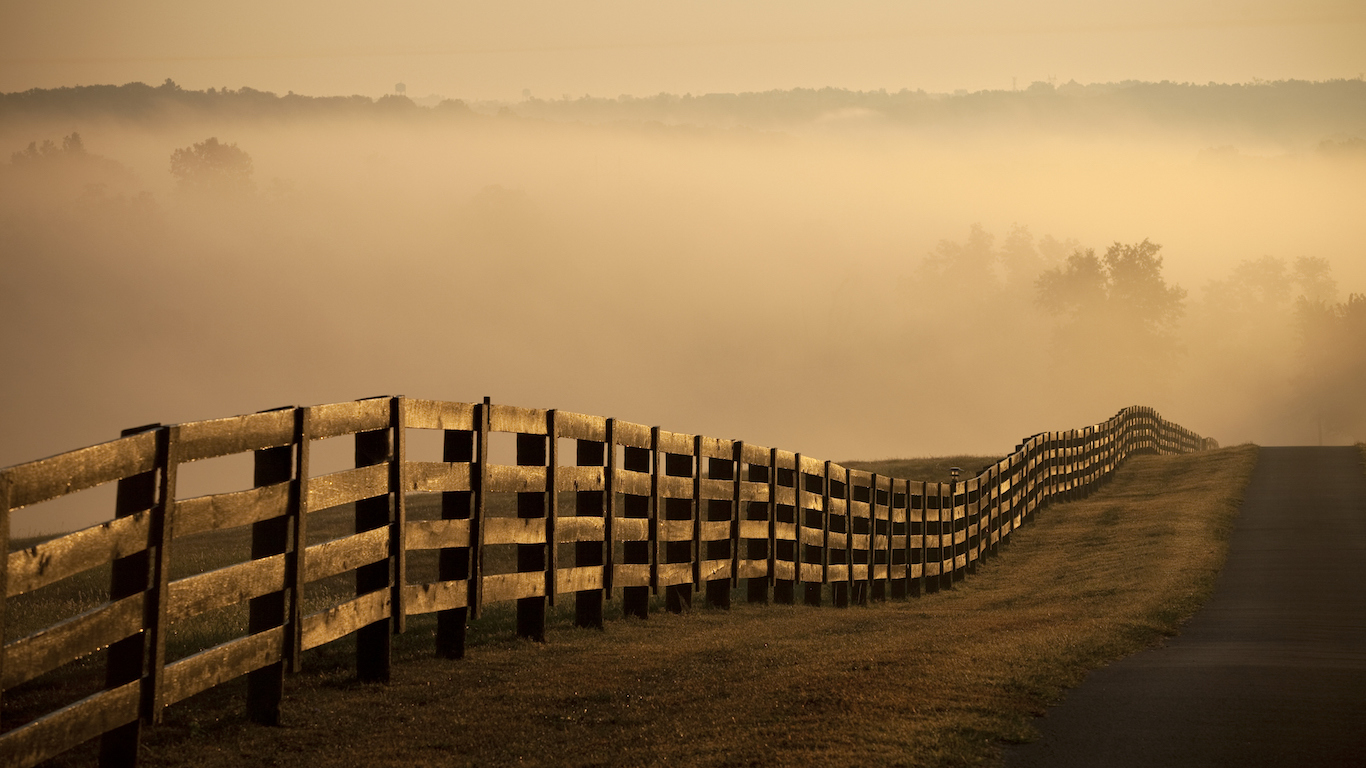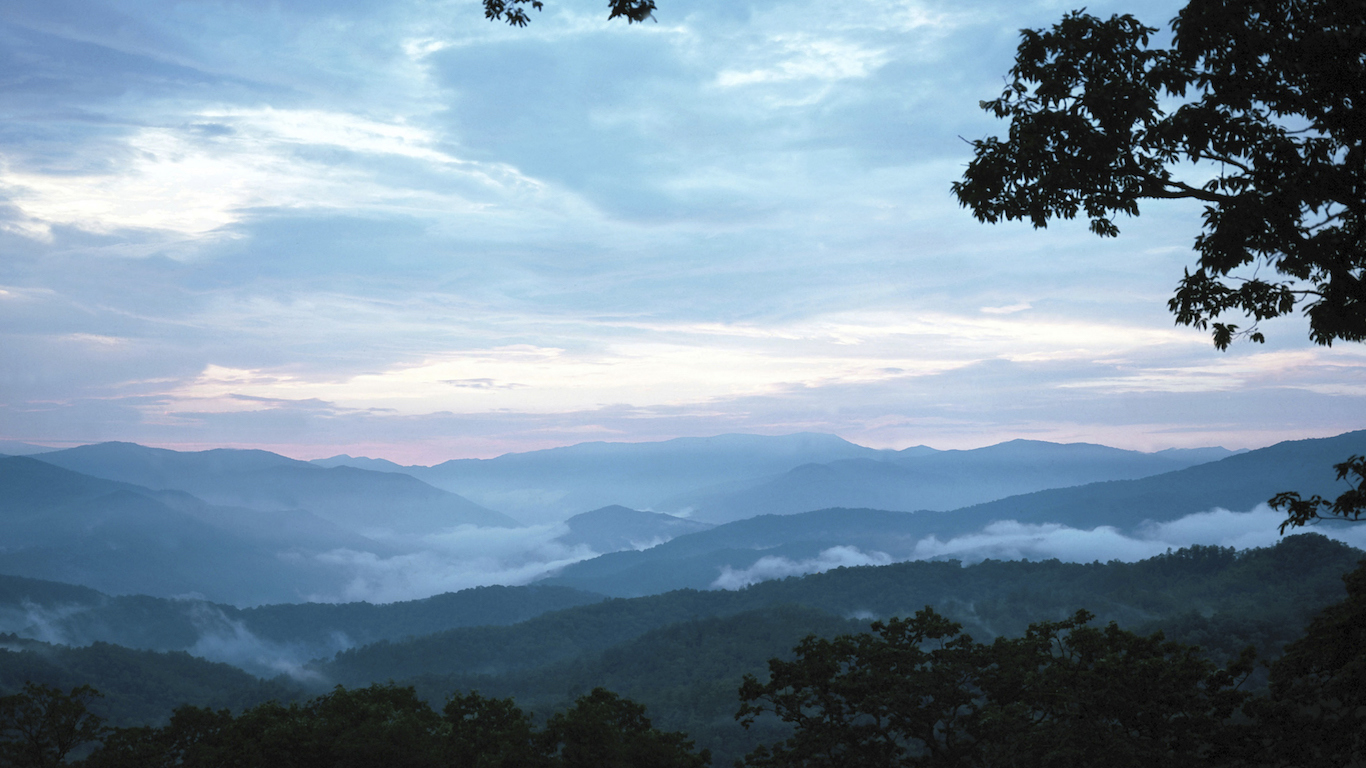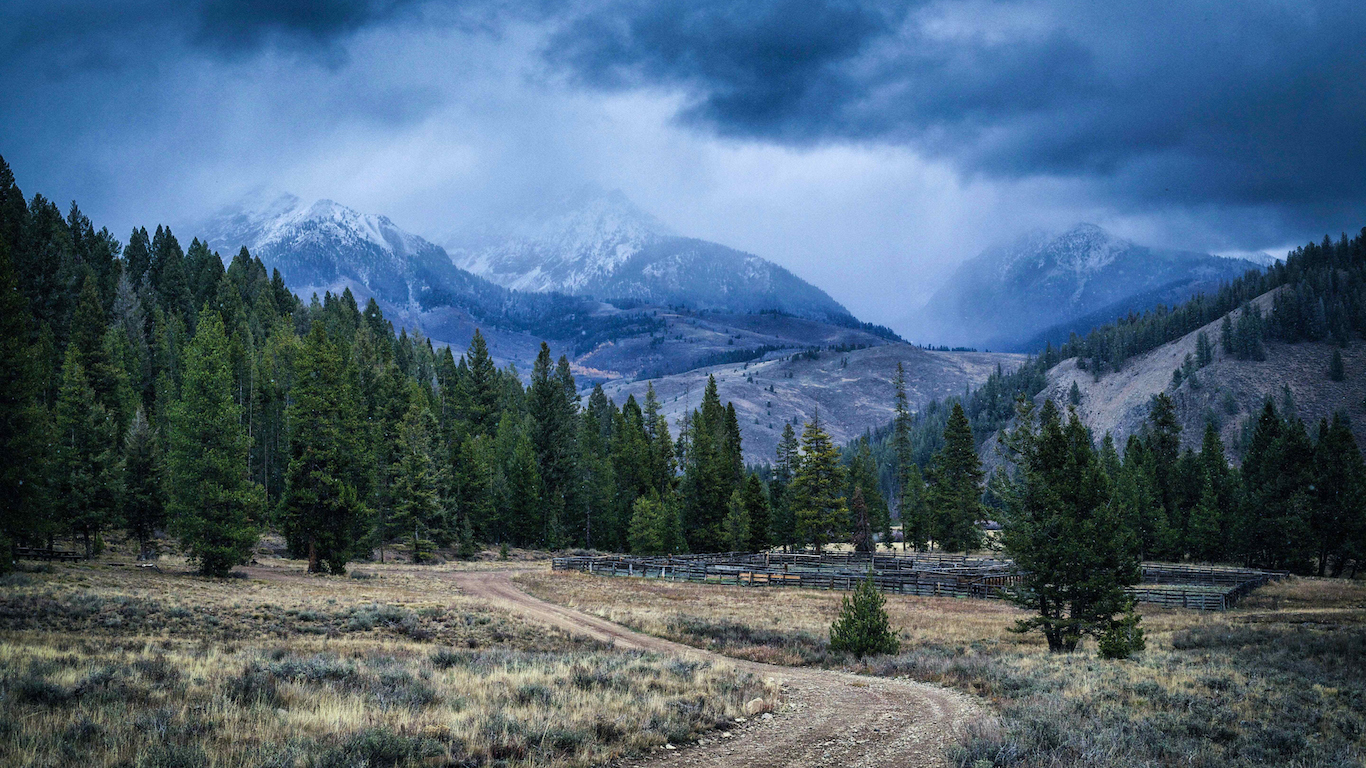Special Report
10 States With the Most Hate Groups

Published:
Last Updated:

According to the latest annual intelligence report from civil rights advocacy group the Southern Poverty Law Center, 917 hate groups were active across the nation last year, up from 892 in 2015, and 784 in 2014.
Because these groups have a tendency to hide the nature of their organizations, these tallies — while the best available numbers — likely underestimate the true levels of hate group activity. Based on data provided by SPLC, Montana leads the nation with 9.6 known active hate groups for every 1 million state residents. Indiana rounds out the list of 10 with 3.9 hate groups per 1 million. Nationwide, there are 2.8 hate groups for every 1 million Americans.
[in-text-ad]
Active hate groups in the United State rose dramatically after former President Barack Obama’s election in 2008. According to SPLC’s count, the number of hate groups surged 800% from 2008 to 2012, when the tally peaked at 1,360 groups. Obama’s race likely led to the hate group spike in 2012. SPLC’s observations suggest the promotion of far-right radicalism in Trump’s campaign rhetoric led to the more recent rise in hate crimes.
Click here to see the 10 states with the most hate groups.
In an interview with 24/7 Wall St., Mark Potok, senior fellow at the Southern Poverty Law Center, said, “Trump’s election has been absolutely electrifying to the radical right.” Over 1,000 hate crimes were counted in the month after Trump’s election, and Trump’s slogan “Make America Great Again” was named by perpetrators in well over a third of those crimes.
According to Potok, Trump and his administration’s rise to power reflects the rise of right wing populism, a movement pitted against government elites and defined by the belief that the United States is a country created by and for white people. However, he added, these sentiments, and the consistent rise in active hate groups, can be traced to longer-term trends — namely, globalization and its consequences for the U.S. economy (the decline in the manufacturing industry in particular) and to population makeup (immigration patterns).
The rise in immigration in the 1910s preceded the unprecedented growth of the Ku Klux Klan in the United States. In 1910, foreign-born Americans comprised 14.7% of the population, and by 1920 that figure was still relatively high, at 13.2%. By 1925, the Ku Klux Klan had grown to some 4 million members, the largest in U.S. history, and following a number of quota-based and other racist immigration policies, the flow of immigrants to the U.S. declined.
Click image to enlarge.
The surge in hate group activity in recent years also coincides with the growth of the U.S. foreign-born population, which at 13.2% of the population as of 2015 is approaching 1910 levels.
Because the flow of new immigrants tends to be greater in areas with already large foreign-born populations, and because individuals seeking residency in the United States tend to avoid areas where they are not welcome, many states with relatively high numbers of hate groups do not have large foreign-born populations. Foreign-born individuals make up 5% or less of the populations in eight of the 10 states with the most hate groups, and on this list, no state’s immigrant population exceeds the national average share of 13.2%.
Potok explained that the ongoing process of globalization brings a range of other economic consequences, including “forty years of falling manufacturing wages, historic levels of income inequality,” and unlike in the past, “the absolute necessity of having a college degree if you expect to be supporting a family on your wages.”
Few states have been spared from the decline in manufacturing jobs in recent years, and plenty of states with struggling manufacturing sectors are not home to high — and often rising — numbers of active hate groups. Still, for states with the highest concentrations of organized hatred, economic decline is likely tied to hate sentiments. In five states on this list — Alabama, Arkansas, Kentucky, Mississippi, and Tennessee — the manufacturing sector is relatively large, with shares of employment in the sector in the top 10 compared with other states. But these are also states where manufacturing employment has fallen dramatically in the past decade. In Arkansas, manufacturing employment dropped by 22% between 2006 and 2015.
These are the states with the most hate groups.
Click here to see full methodology.

10. Indiana
> Hate groups: 3.9/million
> Number of hate groups: 26
> Pct. pop. identifying as white: 84.0% (19th highest)
> Pct. pop foreign born: 4.9% (20th lowest)
The SPLC identified 26 hate groups operating in Indiana in 2016 — a 63% increase over the previous year. Adjusting for the population, there are 3.9 hate groups for every 1 million state residents, one of the highest concentrations of such groups in the country.
Many hate groups in the state operate in Indianapolis. The capital city is home to a KKK chapter, a neo-Nazi group, two black separatist organizations, and a racist skinhead organization called American Vikings. There are over a dozen groups operating in the rest of the state, including a neo-Nazi organization called Gallows Tree Wotansvolk Alliance.
[in-text-ad]

9. Missouri
> Hate groups: 3.9/million
> Number of hate groups: 24
> Pct. pop. identifying as white: 82.4% (20th highest)
> Pct. pop foreign born: 4.0% (13th lowest)
Like many states with a high concentration of hate groups, Missouri has a long history of racial strife. Admitted to the Union in 1820, Missouri’s initial status as a slave state was the subject of bitter national debate. The atrocity of slavery provides a backdrop for racial hatred in the state today. The SPLC identified 24 active hate groups in the state in 2016, including four KKK chapters, four white nationalist groups, and two racist skinhead organizations. The vast majority of the state’s hate groups are either scattered throughout the southern half of the state or clustered in and around St. Louis.
Like many states with especially high concentrations of hate groups, Missouri has a higher share of white residents than the nation as a whole. Some 82.4% of state residents identify as white, compared to 73.1% of all Americans.

8. Virginia
> Hate groups: 4.6/million
> Number of hate groups: 39
> Pct. pop. identifying as white: 68.2% (12th lowest)
> Pct. pop foreign born: 12.2% (14th highest)
Virginia is home to some 39 active hate groups, ranging from KKK chapters to black separatist organizations. As is the case across much of the country, anti-Muslim groups are on the rise in the state. Currently, there are six anti-Muslim hate groups operating in Virginia, twice as many as there were in 2015. Groups primarily motivated by hate of people of a specific religion do not stop there. The state is also home to a number of anti-Semitic Christian groups as well as a neo-Nazi organization.
Another recent trend identified by the SPLC is the rise in anti-immigrant sentiment nationwide. Virginia is home to two anti-immigration groups, one in Arlington and another in Monterey. Animosity towards immigrant populations may be stoked by the relatively high influx of foreign-born residents to the state. Virginia added 330 green card holders for every 100,000 residents in 2015, a larger share than the majority of states.

7. Kentucky
> Hate groups: 5.2/million
> Number of hate groups: 23
> Pct. pop. identifying as white: 87.4% (11th highest)
> Pct. pop foreign born: 3.6% (9th lowest)
The number of hate groups operating in Kentucky increased from 13 in 2015 to 23 in 2016. In keeping with national trends, the SPLC reported increases in the total number of neo-Nazi, white nationalist, and black separatist groups in the state. In addition, the total number of neo-Confederate organizations in Kentucky increased from two to four in 2016. Such groups are unique to the American South.
The Daily Stormer, a neo-Nazi website that championed Trump throughout his presidential campaign, has a chapter in Louisville. The city is home to at least four other hate groups, including three black separatist groups and a white nationalist organization.
[in-text-ad]

6. Arkansas
> Hate groups: 5.4/million
> Number of hate groups: 16
> Pct. pop. identifying as white: 77.5% (24th lowest)
> Pct. pop foreign born: 4.8% (19th lowest)
The number of hate groups operating in Arkansas fell from 22 in 2015 to 16 in 2016. While the number of active groups dropped last year, the Jonesboro-based anti-Muslim group ACT for America was added to Arkansas’ tally. ACT for America was founded in 2007 by Brigitte Gabriel. The group claims 280,000 members and over 1,000 chapters, which would make it the largest anti-Muslim group in America.
Potok noted the rise in hate group activity also has an economic component. Manufacturing jobs that were once pillars of the American white middle class are no longer as widely available or well paying as they once were. Such economic declines are often blamed on foreigners. Total employment in Arkansas’ manufacturing sector declined 22.5% in the last decade, one of the steepest drops of any state.

5. Alabama
> Hate groups: 5.6/million
> Number of hate groups: 27
> Pct. pop. identifying as white: 68.5% (13th lowest)
> Pct. pop foreign born: 3.5% (8th lowest)
As is the case across much of the Southern United States, organized hatred in Alabama is likely rooted in the state’s legacy of slavery. Thousands of racially-motivated lynchings taking place between the late 19th to mid 20th centuries have been documented across the South, hundreds of which occurred in Alabama. And with Dr. Martin Luther King’s protest march from Selma to Montgomery in 1965, it may not come as a surprise that hate group activity in Alabama today tends to be racially motivated. There are currently 11 KKK chapters throughout the state, five neo-Confederate groups, and two white nationalist organizations.
The SPLC identified last year militant anti-immigration hate group Border Keepers of Alabama. The Birmingham-based organization may have as many as eight heavily armed volunteer “teams” it says can be deployed to patrol border towns.

4. Tennessee
> Hate groups: 5.7/million
> Number of hate groups: 38
> Pct. pop. identifying as white: 77.7% (25th lowest)
> Pct. pop foreign born: 5.0% (21st lowest)
There are approximately 38 active hate groups in Tennessee, including 11 under the KKK umbrella. There were 221 hate crimes, mostly racially motivated incidents, reported in the state in 2015.
For members of hate groups, perhaps especially in Tennessee, the decline of the manufacturing sector and the growth of immigrant populations have perhaps helped fuel hate sentiment. According to SPLC expert Mark Potok, there is a perception among hate groups members, particularly the whites, of a lost country. These composition changes in the population and industry go against their belief that the United States ought to mostly contain and largely benefit the white population. Tennessee’s manufacturing sector remains relatively dominant, accounting for 14.4% of non-farm employment, the ninth largest share compared with other states. But the number of Tennessee manufacturing jobs has dropped by 16.7% since 2006, one of the larger such declines in the nation. Tennessee has a relatively small foreign-born population, at just 5.0% of the population. Of foreign-born Tennesseans, 63.6% are not U.S. citizens, the seventh highest such share.

3. Mississippi
> Hate groups: 6.0/million
> Number of hate groups: 18
> Pct. pop. identifying as white: 58.8% (4th lowest)
> Pct. pop foreign born: 2.4% (5th lowest)
Unlike most states with the highest concentrations of hate groups, Mississippi’s white population is relatively small. Residents identifying as white alone comprise 58.8% of the total population, nearly the lowest such share of all states. While three black separatist hate groups were identified in Mississippi, including two chapters of the Nation of Islam and one group called the New Black Panther Party, various chapters of the KKK outnumber all other hate group types in the state.
The recent rise in hate group activity appears largely related to non-white immigration into the United States. However, because the flow of new immigrants tends to be greater in areas with already large foreign-born populations, and because individuals seeking residency in the United States tend to avoid areas where they are not welcome, states with high numbers of hate groups often do not have large foreign-born populations. Immigrants comprise just 2.4% of Mississippi’s population, the fourth smallest share of all states.
[in-text-ad]

2. Idaho
> Hate groups: 7.1/million
> Number of hate groups: 12
> Pct. pop. identifying as white: 91.5% (5th highest)
> Pct. pop foreign born: 5.7% (22nd lowest)
There are 7.1 hate groups for every 1 million people in Idaho, nearly the greatest concentration of any state considered. One of the least diverse states in the country, some 91.5% of the state’s population identifies as white, nearly the largest share of any U.S. state. Despite the state’s relative racial homogeneity, or perhaps because of it, one of the dozen hate groups operating in Idaho is a KKK chapter based in Hayden.
Newly emerging hate groups in Idaho reflect the broader changes occurring on a national scale. The SPLC identified five anti-Muslim groups operating in the state in 2016, groups that were not active as recently as 2015.

1. Montana
> Hate groups: 9.6/million
> Number of hate groups: 10
> Pct. pop. identifying as white: 88.9% (8th highest)
> Pct. pop foreign born: 2.1% (4th lowest)
There are 10 active hate groups in Montana, up from six in 2015. Adjusted to the state’s population of just over 1 million, no state has a higher concentration of active hate organizations. The true level of organized hatred conducted in a state can often be difficult to determine. In Montana, however, white supremacy and far-right radicalism is often closer to the surface than in other parts of the country. They are, for example, talking points of local Montana politician Taylor Rose, who has a history of involvement with white nationalist organizations. Despite his views and affiliations, Rose received broad GOP support and narrowly lost the election for the Montana House of Representatives this past year.
Widespread anti-Islamic sentiment surfaced also after a refugee resettlement program was introduced at the end of last year in Missoula. Over 97% of Montana residents are U.S. natives, the second highest percentage, and just 2.1% of the population are immigrants, the fourth smallest share.
METHODOLOGY
To identify the states with the most hate groups, 24/7 Wall St. reviewed the number of hate groups in each state for every 1 million state residents according to data provided by non-profit civil rights advocacy group Southern Poverty Law Center. To be considered for our ranking, a state needed to have at least 10 active hate groups. Rather than reviewing such factors as history of violence, SPLC identifies hate groups by ideology. These organizations claim that entire groups of human beings are evil by virtue of their class characteristics (e.g., race, religion, origin, gender and so on). For SPLC, to be considered, groups also needed to be active in the year they are listed. Activity needs to be on-the-ground activity, such as holding rallies or simply accepting memberships and selling literature. SPLC provided the names of all hate groups tracked in each state for every year between 2000 and 2015.
We also reviewed the number of green cards issued in 2015 to residents of each state from the report, Yearbook of Immigration Statistics: 2015, published in 2016 by the U.S. Department of Homeland Security, Office of Immigration Statistics. The foreign-born population in each state (the immigrant population), the most common country of birth, the number of immigrants in each state from the most common country of birth, as well as a range of social and economic data, including the percentage of adults 25 and over with at least a bachelor’s degree, the percentage of each state’s population that is white, poverty rates, and median household income, came from the U.S. Census Bureau’s 2015 American Community Survey.
December unemployment rates, and the percentage of each state’s nonfarm workforce employed in the manufacturing sector in each year between 2006 and 2015 came from the Bureau of Labor Statistics.
The incidence of hate crimes came from the FBI’s 2015 Uniform Crime Report.
Let’s face it: If your money is just sitting in a checking account, you’re losing value every single day. With most checking accounts offering little to no interest, the cash you worked so hard to save is gradually being eroded by inflation.
However, by moving that money into a high-yield savings account, you can put your cash to work, growing steadily with little to no effort on your part. In just a few clicks, you can set up a high-yield savings account and start earning interest immediately.
There are plenty of reputable banks and online platforms that offer competitive rates, and many of them come with zero fees and no minimum balance requirements. Click here to see if you’re earning the best possible rate on your money!
Thank you for reading! Have some feedback for us?
Contact the 24/7 Wall St. editorial team.